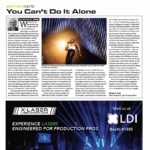The Rig Not Provided
Being in an enclosed venue lets the designers and crew control their entire environment. To a lighting designer, a dark space is like a blank canvas for an artist — endless possibilities. That is, until the audience comes in.
Everyone loves taking photos with camera phones. With the money they spend on tickets, of course they want a photo (or 50) to remember the experience! I am right there with them. The problem is with those built-in flashes.
We have all seen it before — the flashing lights from the crowd. Just look at any major event like the Olympic Ceremonies or the
Super Bowl Halftime show. When the lights go out, the flashes start going. It looks neat, but honestly, do people really think those flashes are going to do anything for them?
I was recently at a smaller theatre tour of an act running up the East Coast. The band was getting ready to come on in a blackout. Though it really wasn’t a blackout. Almost the entire space was filled up with people taking videos on their cameras with the flash on. How annoying!
A Small-Screen View
It amazes me that people spend their precious dollars on tickets to attend shows and then spend the entire time watching it through their phone screens. They are either trying to take photos or videotape the entire thing so they can watch it later or share it on YouTube. What about living in the moment, enjoying the experience of being at the show?
Lets face it, the cell phone, pocket camera and those annoying flashes are here to stay. You can place signs all over the arena saying that flashes are not allowed. Ticket holders won’t care, they’ll still want keepsakes. I say, let’s take advantage of that impulse!
I am probably not the first person to think of this, but it is worth exploring. Why not incorporate cell phone images, videos and flashes into a show’s production design? I’m not going to offer a complete solution here, just the basic idea.
First, to control the camera flashes, gain access to a concertgoer’s images. How about offering fans at the show a free app that goes with the tour? To entice the ticketholder, offer free WiFi service that they can connect to during the show. (I am all about that, as cell and data services get bogged down with so many people in one place.)
Within the app, there would have to be a privacy statement and terms of use that they would have to accept before any service would be allowed. If you want free WiFi on us, we need something from you.
That would be the ability to access any photos or videos that you have taken within the app. Think of it as more cameras throughout the venue doing work for you. Say someone in the front row has a nice shot of the talent and is taking a video of it. You could throw it to I-Mag. It is a win-win for both the ticketholder (their video is on the big screen) and the production crew has another video feed to use.
With photos, you could use the side screens for live photo scrolls that ticket holders have taken throughout the show. The
videos and photos may not be picture-perfect, or even high quality, but content is king, and having more is better than less.
Taming the Flash
Here is where I really get excited about this idea. The app would be able to control the cell phone flash! Say you want a blackout with no flashes going off. Send a broadcast signal that tells the app on everyone’s phone to disable to flash for the black out. The opposite is possible as well. Say you want all the flashes on for a particular song for that added effect.
Of course, all of this hinges on the ticket holders downloading the app, connecting to the production WiFi and using the app. The idea might be great in theory, but, in the end, it will require the cooperation of the audience to work. For longer tours with the right marketing, however, it could be a possibility.
So as a production designer, not only do you have to deal with the lighting, video, staging and set design, you now have to be an app designer. More work, yes, but in the end, you could be creating a different experience with endless possibilities.
For PLSN editor Justin Lang’s Feb. 2014 issue recap, go to www.plsn.me/ednote022014.


